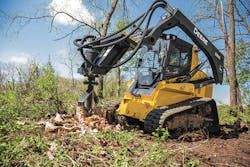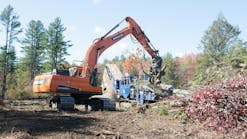Land clearing work varies in scope and size. The scope of the work usually depends on the purpose of clearing the land. For example, when the land is cleared for vegetation management purposes, it usually requires right-of-way clearing, forestry clearing, and tree removal. When land clearing is completed for the oil and gas industry, services typically include brush clearing and seismic operation. And, when the land is cleared for construction purposes, services needed can include tree removal, brush clearing, and soil stabilization.
Large acreage jobs will likely require high production capabilities; wet or swampy conditions will likely require equipment that exudes only a low ground pressure; and residential projects will likely require utilizing smaller, quieter machines.
Land clearing applications are a multi-step process that can require a diverse amount of equipment.
Depending on the material needed to be removed and the final use of the land, Barry Coote, owner, Capital Land Clearing, identifies 11 steps to full-scale land clearing a project.
- Choosing the right equipment
- Taking out the trees
- Skidding felled trees to the stockpile
- Mulching brush and small trees
- Not getting stumped on stumps
- Getting at the roots
- Removing/reducing rocks
- Setting up your wood processing area
- Separating material by market
- Chipping away at the problem
- Loading trucks
Step 1: Plan your work. Examine the site and the expectations for the land use. Ask yourself: “What needs to be removed? What steps do I need to take? What equipment do I need to use? Once I have removed the materials, what can I do with them? What equipment do I need to process them?”
“Planning is an important step in any large site clearing project. The size, type, and value of the wood will drive very different solutions. If the vegetation is relatively small and has no value, a skid-steer, compact track loader, or small dozer may be a good choice for removing the growth and stacking it in a pile. However, if the trees to be removed have value and the job is large, it may make sense to bring in forestry equipment like a feller buncher to fell the trees,” says Nathan Horstman, product marketing manager, crawler dozers, John Deere Construction & Forestry.
“When picking the right tool for the job, first analyze your procedure, then determine which tool works best in that situation. Every clearing job is different and requires careful thought as to which tool works best,” says Mike Noward, Regional Account Manager, Werk-Brau.
“Land clearing attachments are used for clearing woody growth prior to job site development, parks, paths, right-of-ways, along highways, under power lines, and along fences. The applications for land management are limitless,” says Gregg Zupancic, product marketing manager, skid-steers and compact track loaders, John Deere Construction & Forestry.
“Terrain, the density of the vegetation, soil stability, moisture, environmental concerns, and physical obstacles are some of the considerations when choosing the right machine for the application. The required finish and the needed production rates can also be a factor when determining the correct tool for the construction project,” says Tom Hover, product manager, Fecon. “The successful land-clearing contractor will usually approach the job with a variety of units including tracked or wheeled mulching machines, excavator mulchers, and skid-steer tractors equipped with mulching attachments as well as other tools to handle the many tasks found on the average land-clearing site.”
Step 2: Take out the biggest items first. “We go to a feller buncher and remove all the larger trees. That cuts all the wood down,” says Coote.
A feller buncher is a tracked excavator-like machine that is equipped with a harvesting attachment that simultaneously grips and cuts trees. Then it sets down the felled tree away from the next trees to be felled so the skidder can come by and collect it. The feller buncher then moves to the next tree and repeats the process.
John Deere produces feller bunchers. Their machines feature a long, wide undercarriage for greater stability in difficult terrains; strong tractive effort generously increases capability for negotiating difficult or steep terrains, swamp, and snow; a dual swing system that increases power and performance in demanding felling or harvesting conditions; and a variety of boom sets and felling and harvesting attachments so you can customize the machine to the application.
Step 3: “Step three is to use a skidder to haul all the wood out,” says Coote. A skidder is a wheeled machine with a low profile that is equipped with a grapple or a winch, so it can drag trees from the cutting area to a processing area.
“A skidder—or dozer equipped with a winch—can be used to remove the trees, depending on the size of the job,” says Horstman.
John Deere recently upgraded the winches on their cable grapples and the grapples on their grapple skidders. The new two-speed winch increases line pull and is faster than the single-speed winch on previous models while their grapples have gotten larger in size to deliver more wood to the processing area with fewer skids. More grapple-squeeze force provides a constant pressure, so operators are less likely to lose a log, even if a load gets jarred, says the company.
Other new features include tougher tires and new steering sensors that control articulation speed when nearing frame-to-frame contact; this improves operator comfort and cushions impact during full articulation and improving operator comfort.
Step 4: By step four, there are two processes that happen simultaneously—the site clearing activities of the original site, as well as wood processing activities located at a second, nearby site, perhaps occupying a portion of the same property as the land clearing site. At this point, a second crew is brought in to process the wood.
However, we will continue with the original crew clearing the land, and the next step is to remove the brush and smaller trees.
After the skidder has cleared the trees from an area, typically, a brush cutter/chipper or mulcher shreds the brush and small trees using rotating hammers or knives.
Promac Manufacturing produces several brush cutters. “We manufacture high-quality products versus our competitor and brush chipper is no exception,” says Steve Logan, outside sales and technical support. “They are also designed for precision and long life. Our largest unit is 60 inches in diameter and is spec’d to fell trees up to 12 inches in diameter, but I have seen videos of customers using it to fell trees up to 20 inches in diameter.”
Denis Cimaf manufactures lines of mulcher attachments for excavators, skid-steer loaders, and compact track loaders. They bucked the trend when they equipped their mulchers with blades instead of hammers.
“Would you rather cut down a tree with a hammer or an ax? That is a question that the company owner used to ask people,” says Pierre-Luc Boivert, marketing manager, Denis Cimaf. “Our salespeople still ask that question.”
The Denis Cimaf DAS mulcher models are designed for skid-steer loaders and compact track loaders. The Denis Cimaf DAH mulcher models are designed for excavators.
Dozers have the traction and pushing power to fell trees of this size, as well as remove/trample much brush.
Depending on specifications, the brush can be tilled into the soil or cleaned up and transported to the wood processing site.
To handle the brush and small trees, an excavator equipped with a progressive link thumb is ideal.
A progressive link thumb attaches to excavator buckets and allows for action similar to the thumb on a human hand. Using this method, an excavator operator can scoop the brush with the bucket and clamp down on it using the thumb. This decreases the amount of material spillage when moving the brush.
“Progressive link thumbs and standard thumbs pinch or hold the material to assist in loading into hoppers or trucks,” says Noward.
Once everything above the soil is removed, it is time to address what is in the soil and needs to be removed.
Step 5: “At step 5, we begin the subsoil operations,” says Coote. Stumps are both above and below the surface. When removing large stumps, you can use either a tree spade or a stump grinder.
A tree spade cuts into the earth in an upside-down pyramid shape, cutting the trunk from its roots (and taking with it all the dirt inside the cut). This keeps the stump in contact for markets that want whole stumps.
Tree spades can be attached to skid-steer loaders, compact track loaders, or excavators.
“Typically, for compact track loaders and skid-steer loaders, a higher-performance hydraulic system is suggested for efficiently powering these kinds of hydraulic thirsty attachments,” says Zupancic. “Additional operator protections like a poly-carbonate front door and a level II FOPS (Falling Object Protection System) are required. Also, winches or additional forestry protection kits designed to prevent debris from entering the machine or protect key machine components are recommended.”
A stump grinder can attach to the same machines; it grinds stumps at the location of the stump.
The Fecon Stumpex line of stump grinders, for example, is different than most stump grinders. Typically, stump grinders are equipped with several rows of fast-moving teeth (hammers), but Fecon’s StumpEx uses a set of slow-moving blades set at about 30 degrees to the stump. The slower rotation of the StumpEx means fewer wood chips get thrown by the attachment, and the chips get thrown a shorter distance and with less power behind it compared to a typical stump grinder.
Step 6: Often, land clearing contractors must deal with the roots of the trees. For the most part, they can be left in the ground so long as they are shredded to small pieces. In order to shred wood below the surface, contractors rely on attachments such as forestry tillers.
“A forestry tiller is like a rotary tiller on steroids. The head goes into the ground up to a depth of 24 inches and it chews up stumps and roots and mixes them into the soil,” says Coote.
“The ability to put the material back in the ground is a huge benefit,” says Giorgio Carera, president, FAE. “Our most common forestry tiller line includes the SL, SSM, and SSH, but we also offer a multi-task line—the SFM and SFH—which can do the stumps and handle and slash what is left behind as well.”
The FAE forestry tiller features a patented rotor design, a forestry counter knife, and grid to allow for better processing of the debris and a finer final product, as well as a self-leveling gearbox to allow for a better PTO angle while working.
A forestry tiller attachment can be attached to a skid-steer loader, compact track loader or excavator, or to another type of machine called a dedicated track mulcher or prime mover. A prime mover is almost a cross between a dozer and a municipal tractor in its appearance, but it is designed specifically for land clearing applications.
Capital Land Clearing employs a PrimeTech prime mover (manufactured by FAE).
“Our machines also have a low ground pressure option to allow us to cause the least ground disturbance as possible. An interactive display [...] allows you to see what all of your systems are doing, also allowing you to troubleshoot, test, and calibrate our hydraulic system and components in a very detailed manner. Different attachment options allow our PT line to take a land clearing job from standing timber to plantable ground but using a combination of our machine attachment to clear material and then swapping to a hydraulic forestry tiller or stump grinder,” says Carera.
Step 7: Wood is not the only material that is popular in soil and needs to be removed during land clearing projects. Rocks are another factor with which land clearing contractors must deal.
“In order to remove stones too big to leave in the ground, I will often use an excavator equipped with a bucket or a rake attachment,” says Coote.
Werk-Brau manufactures several excavator bucket types and rakes.
“Sometimes, contractors will first go in with some type of hammer or ripper and then come back with a bucket,” says Noward.
A hammer looks and functions similarly to a handheld jackhammer; it is used for breaking up large rocks and can be attached to a skid-steer loader, compact track loader, or excavator.
A ripper is an attachment with one to four prongs that cuts through the earth. This action cuts through the hard ground so it is easier for excavator buckets to excavate, and it helps bring rocks closer to the surface. The attachment can be found on the rear of a dozer or on an excavator.
“For clearing the stony ground, Werk-Brau offers a lot of buckets, including severe-duty rock buckets and buckets with rippers on the back of them and a Cincinnati bucket that is designed to rip through the shale ground found in and around Cincinnati,” says Noward.
“Once all the vegetation and organic material is removed, the dozer can be used to bring the area to the intended grade for the next stage of the land’s development,” says Horstman.
At this point, depending on the final use for the site, the land clearing activities of the first crew are done. They just need to pack up the equipment. However, for the second half of the first crew’s activities, the second crew has simultaneously been working. Here are the steps they take to complete the processing end of a land clearing operation.
Step 8: The first step taken by the wood processing crew is to look at the wood processing area and determine what is the most efficient and safest way for processing wood and hauling it out. When the team arrives onsite, there is already a stockpile of felled trees that were placed there by the skidder. The team must then set up three more stockpile areas, the de-limber, horizontal grinder, and chipper, as well as a truck loading station and truck routes in and out of the area.
“Onsite considerations should include the type of raw material, placement of raw material that needs to be processed, and what support equipment that is readily available to feed the grinder/chipper. All of these items play a factor in the overall efficiency on a job site,” says Michael Stanton, Director of Industrial Products, Morbark, LLC.
Step 9: Once the equipment is set up, the first task is to examine the wood that has been stockpiled by the skidder and separate the salvageable wood from the waste wood. (Salvageable wood includes whole logs and firewood.) Capital Land Clearing uses a de-limber to strip smaller branches from the trunk so the salvageable wood can be separated.
A de-limber attachment attaches to an excavator or dedicated forestry machine. It grips a tree and strips all of the limbs from it so the only part that is left is the trunk. Trunks are placed into one stockpile and wait to be hauled out. The waste wood gets placed in a separate stockpile and waits for further processing.
Step 10: “Then we take the tops and the small branches and run that through a horizontal grinder,” says Coote.
The latest horizontal grinders from Morbark include the 3400XT and the 6400XT. “The Model 6400XT is designed with sloped infeed sides, a 40-inch-diameter feed wheel, a 42-inch-diameter hammermill with three-inch rods, and heavy WDH-120 chain infeed bed is perfect for the harsh and various grinding condition in site clearing applications,” says Santon. “While the Morbark Model 6400XT has a single point drive belt tensioning system, consolidated filter placement increased working platform and hydraulic hood pins all result in ease and time saving during common maintenance procedures.”
Morbark horizontal grinders feature a breakaway torque limiter driveline protection system that protects against catastrophic damage from contaminants and the Morbark Integrated Control System (MICS) is designed to maximize production and engine efficiency. An aggressive feed wheel with an internal porcelain drive that has no chains or sprockets increases torque and reduces maintenance. And with the optional Morbark Quick Switch Grinder-to-Chipper Conversion Kit, you can use your Morbark Wood Hog to produce high-quality and highly profitable biomass fuel chips or sawdust.
Alternatively, contractors can use a drum tree chipper.
Morbark offers a full line of whole tree drum chippers in a range of sizes and in several configurations, such as with cab and loader (WCL) or no cab and loader (NCL), on tracks or tires, diesel or electric. With their rigid structural frame and powerful internal-drive, single-feed-wheel infeed system, Morbark chippers can chip small, unsaleable material into saleable material. All but the M20R Forestry can be equipped with “microchip” drums for meeting the “micro” chip specifications needed for pellet manufacturing, animal bedding, etc.
Step 11: Salvageable wood must be loaded onto a trailer and hauled out. Capital Land Clearing ships the tree trunks to a local mill.
There are several methods for loading trailers with wood. Either you can use a wheel loader equipped with a grapple attachment onto a (type of trailer) or you can use a trailer equipped with a grapple.
Grapple attachments are often used in forestry and can be useful on land clearing projects.
ProMac Manufacturing manufactures a yarding grapple; it uses cables instead of hydraulics to manipulate its tines. “Our yarding grapple features a tapered rolling bearing carriage versus a bushing on competitive products. A tapered rolling bearing carriage has the advantages of lasting longer, costing less, and less resistance,” says Logan. “Also, grapples tend to get abused, so we designed ours with QT100 high-strength material that is 2.5 inches thick.”
Chipped material can be sprayed directly into an enclosed trailer; this makes loading easy. If the trailer can’t be present during the time the chipper is in use, the chipped material can be stockpiled and then loaded onto a trailer using a loader.
“And then we truck all the chips offsite; the chips are primarily used for the creation of hog fuel.”
Once all the material is processed and hauled away, the contractor just packs up his equipment, and the land is ready for the next step in its development.




